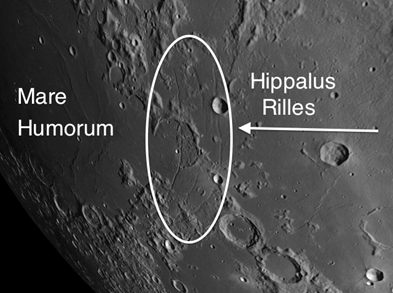The week of April 15-21 takes us from Day 8 to Day 13. This week we will highlight Rimae Hippalus, the Hippalus Rilles, viewable on Thursday and Friday evening and located in the SW quadrant of the Field Map at M7.
 Rimae Hippalus: [SW/M6; L=29°W] On the east shore of Mare Humorum, you will find the remnant of the moon crater Hippalus whose southwest rim, because of subsidence, has disappeared into the mare. The area around Hippalus contains the finest examples of arcuate rilles to be found on the Moon. Each one is about 2 miles wide. (Catch these rilles when the terminator is around 40° west which will be the case on Tues. evening.) Notice how some of the rilles plough through mountain ridges and craters, and some are interrupted completely by small craters but continue on the other side. One prominent rille cuts straight through the middle of Hippalus. This gives you a clear indication of the sequence of activity. What features were in place before Humorum filled with lava and subsided? What features appeared after subsidence took place?
Rimae Hippalus: [SW/M6; L=29°W] On the east shore of Mare Humorum, you will find the remnant of the moon crater Hippalus whose southwest rim, because of subsidence, has disappeared into the mare. The area around Hippalus contains the finest examples of arcuate rilles to be found on the Moon. Each one is about 2 miles wide. (Catch these rilles when the terminator is around 40° west which will be the case on Tues. evening.) Notice how some of the rilles plough through mountain ridges and craters, and some are interrupted completely by small craters but continue on the other side. One prominent rille cuts straight through the middle of Hippalus. This gives you a clear indication of the sequence of activity. What features were in place before Humorum filled with lava and subsided? What features appeared after subsidence took place?
OF ADDITIONAL INTEREST IN SPACE
On Saturday, Jupiter is 0.5° south of Uranus (binoculars required for Uranus).
It is highly recommended that you get a copy of Sky and Telescope’s Field Map of the Moon, the very finest Moon map available for use at the telescope. It is available for $10.95 at www.skyandtelescope.com and on Amazon. All features mentioned in this blog will be keyed to the grid on the Field Map and will look like this: Plato: [NW/D9]
Credits:
Courtesy of Gray Photography of Corpus Christi, Texas
Lunar photos: NASA / USGS / BMDO / LROC / ASU / DLR / LOLA / Moon Globe. Used by permission
- Rupes Cauchy: A Best Known Fault on the Moon - July 22, 2024
- Moon Crater Schickard – Crater Floor has Stripes - July 15, 2024
- Moon Craters Langrenus and Vandelinus - July 8, 2024